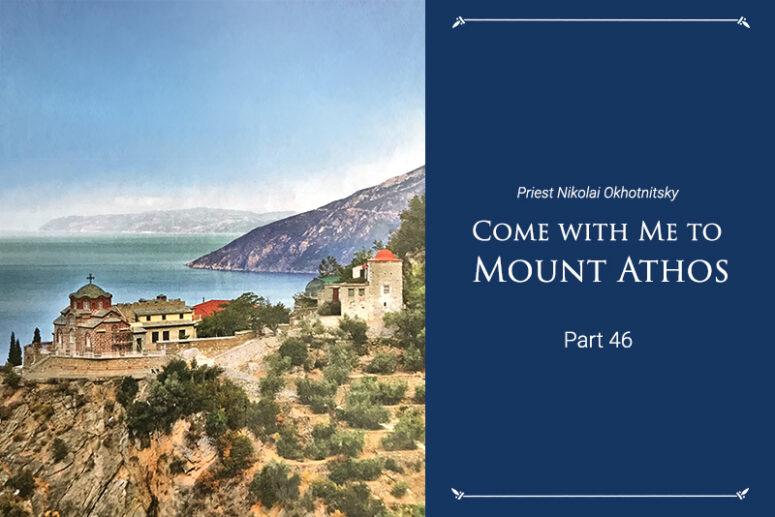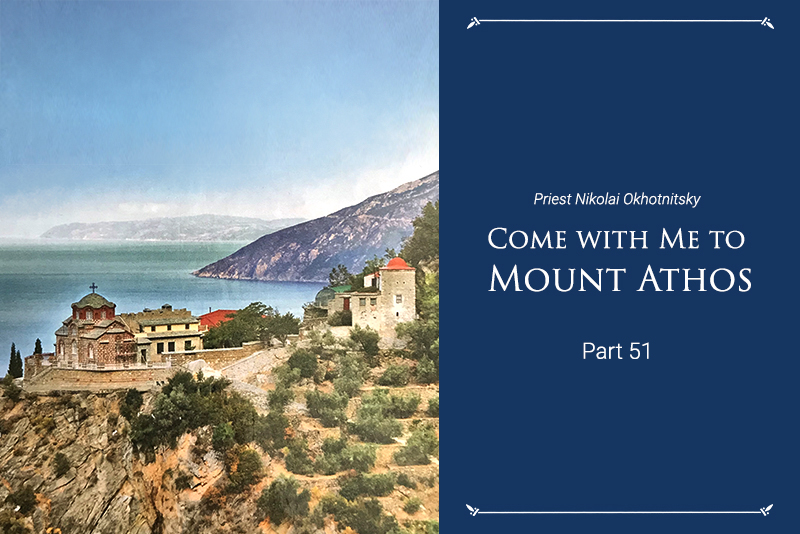
Mountain-high Experience
The variety at the Dionysiou monastery icon shop is quite limited, so we went on without stopping there.
To leave the monastery grounds, we had to go through the Northern gates. First our path lay past some kind of a construction terminal with gravel and five-ton dump trucks, down to the sea, then parallel to the embankment, along the water’s edge and finally all the way to the beginning of the mountain range, descending almost sheer into the sea. Somewhere there begins our route. The well-maintained road led to a bridge over a dry stream. Now we had to find the narrow path towards St Gregory monastery off the gigantic stairs, leading vertically up to some local landmark. Our walking sticks got back to knocking on the concrete.
Previously, construction materials were lifted here using manpower and mules. Today, industrialization and globalization have come to this land as well. One does not need to be a clairvoyant seer to predict the close end of Athos distinctive character. Everything that has a beginning will come to an end. The course of change today is a historical and all-destroying process, which no longer depends on us. The seductive spirit of pride pushes us to be revolutionaries, to try to change something, to participate in protests and demonstrations in search of truth and justice. However, the truth lies in the personality of Christ, and not in the world order. Truth is the “Who”, and not the “What”. Diverting our attention here and there, we forget to look into our own hearts, leaving them in absolute desolation and disorder. “Oh, no! The world is coming!” Clearly, the story of the ninevites does not teach us anything.
Today there is a lot of talk about the end of the world, which will come sooner or later. Before it does, however, Athos will remain a place where the sovereign mistress is the Mother of God. Our cumbersome prayer with the knocking of our pilgrim’s sticks was our feasible contribution to that part of the historical process.
It was early October, and the air was hot. In our country, we have this kind of weather in July, when the turf moors are smoking. Having found what seemed to be our path, although with no road sign, we made the sign of the cross and began climbing the stones towards the sun. We did not keep time, but I was guessing that it was around noon. Although various guidebooks say that St Gregory monastery is about an hour and a half walk, it took us three hours to get there. We are neither chamois nor argali, so we made long halts. Besides, there was no hurry. The first days of our pilgrimage had taught us a lesson, and we were not worried about being late. We knew that everything would be fine.
We were already at the height of the Dionysiou monastery. After a farewell look, the ascent continued. We had to overcome several mountain spurs. Every time a descent began after another turn, we expected our destination to appear, but the descent ended with another ascent. We climbed even higher. Because of physical weakness, we entered a kind of an automatic mode. It was very similar to flying on autopilot. My tiny consciousness was sitting inside my skull, like a pilot in the cockpit, looking blindly out the window and barely controlling the body. Step. Knock. Skirr. Inhale. Exhale. Small stones were crumbling from under the shoes. It took constant strain to control our feet so as not to twist an ankle. The Jesus Prayer did not stop, but it was no longer sung fervently. We were leaning on it like on a second walking stick.
In my distant student days, when I was still mountaineering, I used to dream of the mountains. However, as soon as an ascent began, I silently scolded everything in the world. I chastened the mountains, my companions and myself for being stuck doing something as pointless as mountain climbing. Of course, I did not show it in any way, because everyone would think that I was a weakling. Truth be told, all these feelings disappeared at the top, yielding to uncontrollable excitement. Then came the descent, and again I regretted not having preferred to lie somewhere on the beach… Here, on the Holy Mountain, I never got upset or regretted such an irrational (from a worldly point of view) pastime even when it got very difficult.
We slept very little, but still we felt cheerful. Perhaps these were works of grace and the effect of the prayerful atmosphere, or maybe it was just the excitement of newbie pilgrims.
Finally, we started noticing signs of human habitation, such as a fence for wild animals. Another small ascent, and there it was, down below. The tower and walls of St Gregory Monastery looked as if it was on the palm of your hand. We almost made it. We began to descend along the terraces with olive trees. Our legs sped up and carried us towards the water in misted glasses and the cool shade in the monastery walls.
Translated by The Catalogue of Good Deeds
Part 1
Part 2
Part 3
Part 4
Part 5
Part 6
Part 7
Part 8
Part 9
Part 10
Part 11
Part 12
Part 13
Part 14
Part 15
Part 16
Part 17
Part 18
Part 19
Part 20
Part 21
Part 22
Part 23
Part 24
Part 25
Part 26
Part 27
Part 28
Part 29
Part 30
Part 31
Part 32
Part 33
Part 34
Part 35
Part 36
Part 37
Part 38
Part 39
Part 40
Part 41
Part 42
Part 43
Part 44
Part 45
Part 46




